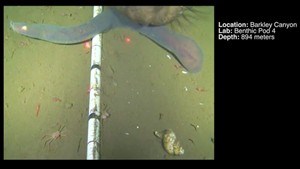
A frame grab from video shows a sighting of a northern elephant seal nearly a kilometre below the surface hunting a hagfish. A teenager from the Ukraine was watching the webcam located deep in the ocean of British Columbia capture the rare sighting posted a video to YouTube. Researchers checked it out and say it's the first time one of these seals has been actually seen/videoed hunting on the ocean floor. THE CANADIAN PRESS/ho-Neptune Canada
January 30, 2013 - 1:27 PM
VANCOUVER - Kirill Dudko was sitting in front of a computer in eastern Ukraine, watching a live video feed from a deep-sea, underwater camera nearly a kilometre below the surface off Vancouver Island, when the 14-year-old saw signs of life.
A hagfish — a slithery grey animal that looks like an eel — was stretched across the screen. And then, without warning, a round, whisker-covered nose peeked into view and quickly snatched the hagfish away.
The mystery predator's appearance barely lasted a second, but Dudko was intrigued. He captured a video of the incident, posted it to YouTube and then contacted the University of Victoria-based research group that runs the camera to ask an obvious question.
"I really want to know what it was," Dudko writes in an email from his home in Donetsk, Ukraine, about 700 kilometres southeast of Kyiv near the Russian border.
"It was so unusual! I wasn't sure that any mammal except a whale could dive so deeply, but it did not look like a whale!"
Dudko emailed Neptune Canada, which operates several deep-sea webcams off the coast of British Columbia, and pointed them to his video.
Researchers at Neptune, in turn, consulted experts along the West Coast of Canada and the U.S., who all agreed about what Dudko had seen: a northern elephant seal, which had never before been captured on video hunting prey on the sea floor.
Dudko, who says he has been interested in biology for years, was elated. Neptune dubbed him a "citizen scientist" and his short YouTube clip has been viewed nearly 150,000 times.
"I am very proud — real scientists call me a scientist!" he writes.
Researchers at Neptune say they hope more people will take Dudko's lead and connect with science through technology. In fact, the group is relying on web-savvy "citizen scientists" to comb through thousands of hours of video footage from the ocean floor through a project called Digital Fishers.
Kim Juniper, scientific director for Neptune, says he and his colleagues were thrilled when they saw Dudko's footage.
Scientists already knew that elephant seals hunt for food at great depths, but they had never seen one of the animals in action, he says.
"It's an amazing event to witness," says Juniper, who is also an oceanography professor at the University of Victoria.
"It's impossible to chase seals around when they dive to hundreds or thousands of metres, so it's the first time this feeding behaviour has been observed in the deep sea."
Juniper and his group want more people to help examine video footage from the bottom of the ocean in a crowd-sourcing project, Digital Fishers, which started in 2011.
In addition to its web cameras, Neptune sends underwater devices that move around on the ocean floor to capture video. The group has 9,500 hours of video footage that has yet to be examined by scientists.
On the Digital Fishers website, users are asked to view 15-second clips and use drop-down menus to record what they see, such as animals, hydrothermal chimneys or strange objects.
The results are then fed into a database to identify what's on each piece of video.
"Even if some people make inaccurate observations, if you get enough, you eventually come to an agreement on what's really there," says Juniper.
"That helps the scientists pick out the segments of video with content they might be interested in."
Juniper says his group is looking for other ways to harness Internet users for its research.
Late last year, Neptune's parent organization, Ocean Networks Canada, launched the Coast Buster smartphone app, which allows users to photograph and report debris from the 2011 Japanese tsunami as it reaches North American shores.
"I think we see a lot of promise in it, but at the moment, it's still experimental for us — we're discovering what works and what doesn't," says Juniper.
"This latest thing (with Dudko's video) was a surprise, and I think we're going to pursue this more and encourage other people in the crowd to dig through our data."
As for Dudko, he tunes in to the Neptune underwater camera video feeds pretty much every day, posting interesting clips to YouTube.
"I was impressed by the fact that it is possible to observe the life of the inhabitants of the deep sea online," he writes.
"I must confess (the attention from the elephant seal video) is a bit unexpected for me. But I like it."
———
Online:
http://youtu.be/05GasKiM4l4
http://digitalfishers.net/
http://www.neptunecanada.ca/news/live-video/
News from © The Canadian Press, 2013